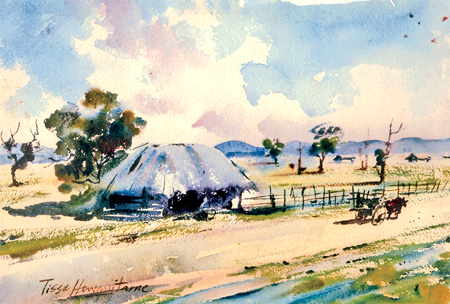|
Painting 101:
Aspects of landscape drawing and painting
by Tissa Hewavitarane
By comparison, the landscape is invariably relegated to space between
the action-trees, hills and forests serving as handy composition devices
or tactical props that satisfy artists. Every artist must quickly
familiarise himself with the key elements of landscapes. He must seek
terrain that gives cover and identify the various points for safe
observation and estimate the possible hazards.
|

A landscape painting in watercolour |
The skills are worthless unless they are committed to paper and
recorded. And of course the most useful way of describing any landscape
is through drawing and painting. It is more exacting than photography
much quicker than map-making, rather less risky than blundering ahead
into a hazardous and unfamiliar terrain. In outdoor sketching and
painting carried perspective, shading texture and tree shapes-though the
advice on how to describe a electric post is perhaps less useful for
today's painter.
Where to start
Every art instructor and beginner in art ought to know the difficulty
in selecting a view and beginning to make a sense of the visual
confusion of a landscape. Some instructors may recommend using
binoculars to resolve particularly obscure parts of the view, these have
the added advantage that they flatten off natural forms making them
easier to transcribe to paper. What you must aim to do is simplify what
you want to draw. You have lot of freedom, you may remove unwanted
trees, buildings or lamp posts.
Identifying key points
Once the basic out line of the whole landscape is put on paper, the
next important step is to identify the key points to draw and paint.
Before painting you have to pick what colours you choose for a specific
scene. The scene depends on the location and the weather. If it is a
sunny day or a rainy day or some days with mist.
James McNeil Whistler, the famous landscape painter was right when he
said, "Seldom does nature succeed in producing a picture". What he meant
was that a scene which is breathtaking to the naked eye may appear less
exciting when it is translated into paint on a square sheet of paper.
Often, it isn't enough simply to copy the subject in front of you,
sometimes you may have to add, subtract or regroup one of the elements
in the scene to create a more balanced image.
It is simply the means of arranging the parts of your picture so that
they add up to a harmonious whole. A badly composed picture will look
disjointed and faintly irritating. A well composed picture fits together
in a satisfying way and pleasing to your eye, just as a play or film.
Often has one main character and a supporting cast. In choosing subjects
begin with simple subjects which demand a few colours. For example, a
tree, a country lane, or a fence in the hedge.
When you have selected a subject it is a good idea to make a few
rough sketches. Always keep a sketch book with you so that when there is
no time to paint, you can make a quick sketch. Water is an endlessly
fascinating a subject-matter and many people find landscapes which
include both serene and peaceful scenes. Ponds, rivers and the sea
constantly attract artists, but many when beginning to paint shy away
because they find it difficult to paint water.
The important thing to remember is to forget about the surface and
look deeper. Squint your eyes. Look for large light or dark shapes, the
colourful patchwork that reflects sky and landscape. Put it together
like a jigsaw puzzle, add a few horizontal ripples and the water is
painted.
Handling perspective
Perspective was acknowledge to be the most common fault in many
paintings and it's often a stumbling block for many artists. Naturally
so much can be learned from sketching in the hands of a refined artist
and the results are quite remarkable than that of a novice. The first
thing we need to establish is the artist's eye-level which will
determine the horizon line in the picture. For most people the horizon
is where the earth meets the sky; but for the artist, the horizon is at
eye-level, intersecting with an imaginary eye-line running straight
ahead from the eye. Therefore, if the artist is sitting, the eye-level
will be lower than if he or she was standing so too is the horizon.
There are three different sorts but they're all quite easy to
understand. There is one point perspective which is where all the
parallel lines seems to converge to a single vanishing point.
Two point perspective is the most common, which is when the parallel
lines seem to converge on two points on the horizon, as when you're
painting a house and can see two sides.
Last is three point perspective but it's not much used unless you
happen to be painting a sky-scraper from above, or a church tower from
close to its base. This is when parallel lines seem to converge on two
points on the horizon and another vanishing point either above or below
the horizon line.
Regarding the drawing of figures or animals in perspective imagine
you are standing one flat plain looking into the distance. There are
figures in the foreground, middle distance and in the distance. You will
need to draw them so that the horizon cuts them at eye level with
sitting figures little lower. Think of perspective not as an adversary,
but something that can be studied at any moment.
Need constant practice
The watercolourist can't guess and he may make only minor
corrections. He works by elimination, by paring a subject down to its
essentials. Water-colour, therefore, is the ideal medium for capturing
the effects of light and is a medium that is fresh, alike and responsive
to the moment and the shifting moods of nature. This medium too like
other arts needs practice.
www.tissahewavitarane.com
|

